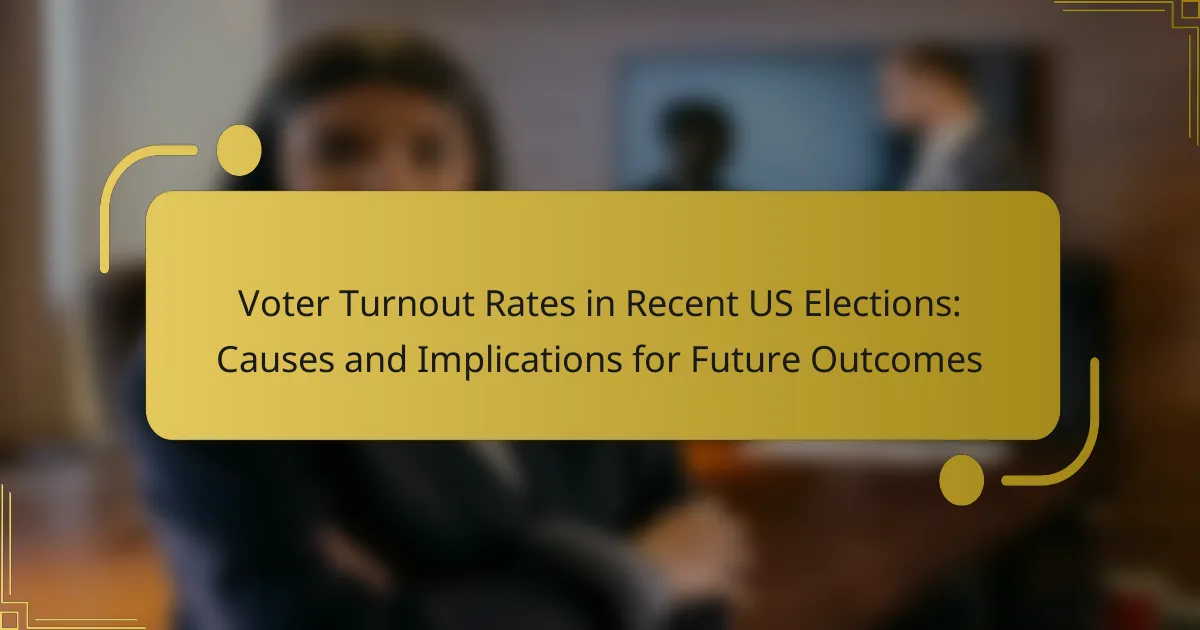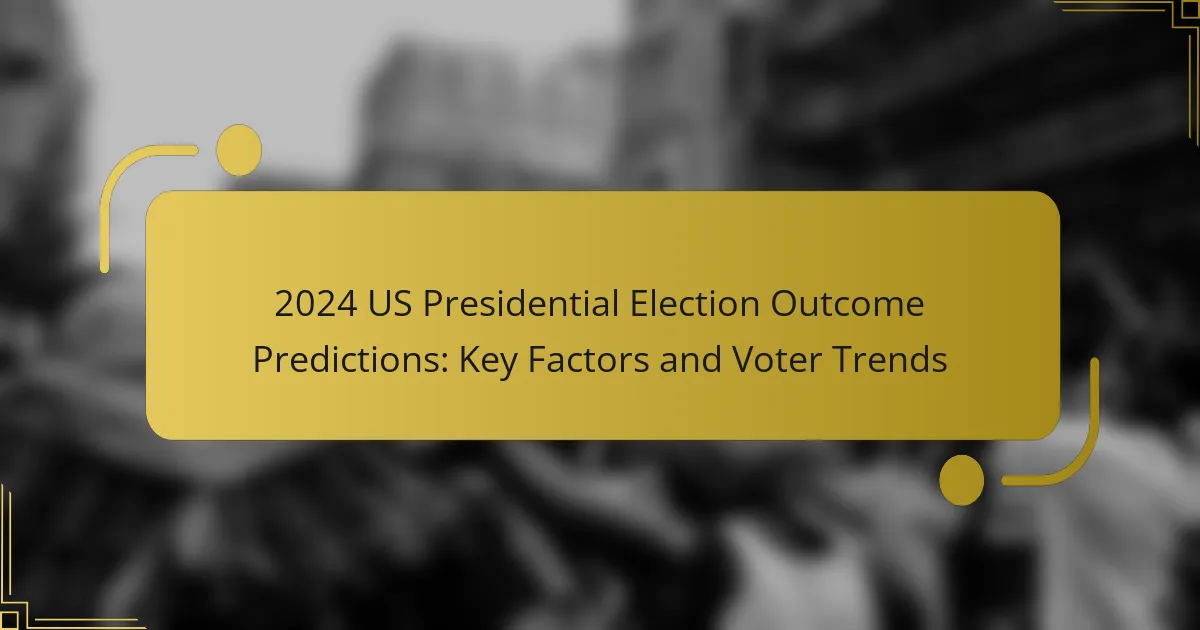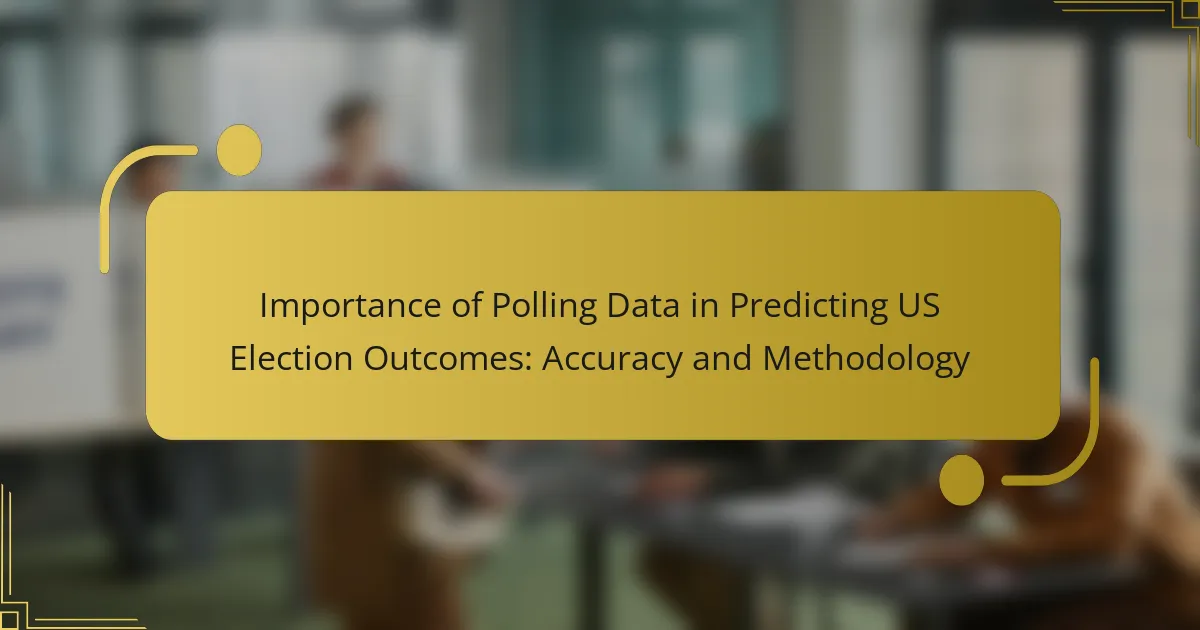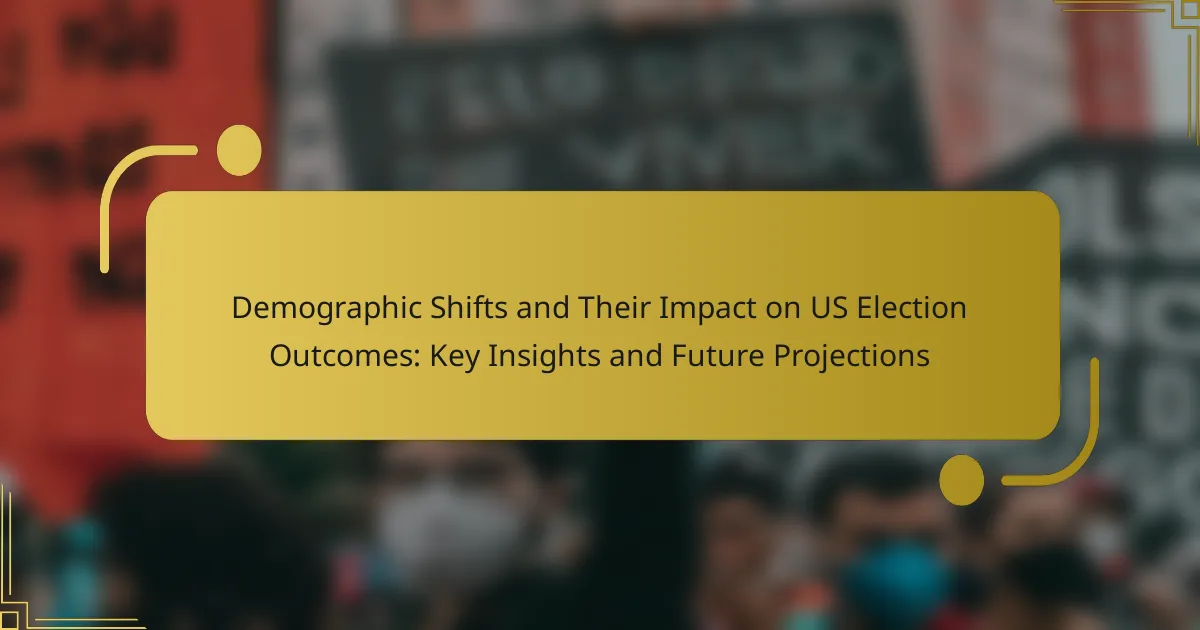Voter turnout rates in recent U.S. elections have shown significant variation, with the 2020 presidential election achieving a turnout of approximately 66.8%, the highest since 1900. The 2018 midterm elections also saw an increase, with about 50% of eligible voters participating, reflecting a trend toward greater voter engagement. Factors influencing turnout include demographics such as age, education, and income, as well as geographic location and the competitiveness of elections. Higher voter turnout leads to more representative outcomes, impacting policy priorities and encouraging political engagement. Understanding these dynamics is crucial for evaluating the implications of voter turnout on future elections and democratic processes.
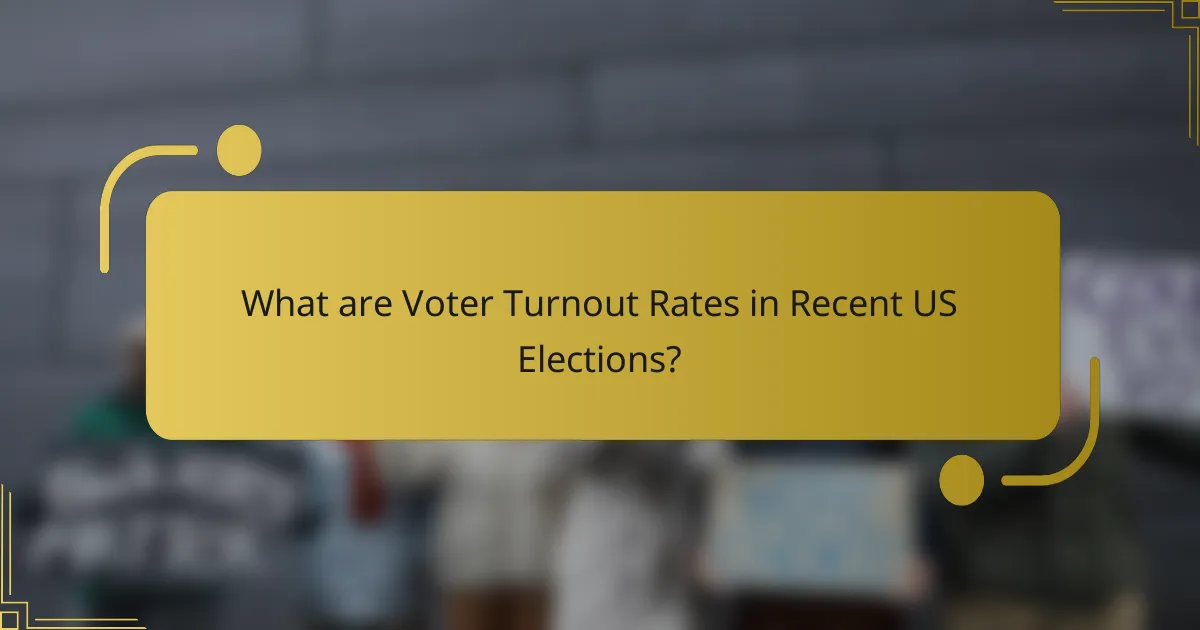
What are Voter Turnout Rates in Recent US Elections?
Voter turnout rates in recent US elections have varied significantly. In the 2020 presidential election, approximately 66.8% of the eligible voting population participated. This marked the highest turnout rate for a presidential election since 1900. In the 2018 midterm elections, voter turnout was about 50% of eligible voters, which was notably higher than previous midterms. The turnout for the 2016 presidential election was around 60.2%. These statistics highlight a trend of increasing voter engagement in recent years.
How are Voter Turnout Rates measured?
Voter turnout rates are measured by calculating the percentage of eligible voters who cast ballots in an election. This calculation typically involves dividing the number of votes cast by the total number of eligible voters. The U.S. Census Bureau and the Federal Election Commission provide data on eligible voter populations. For example, in the 2020 presidential election, approximately 159 million Americans voted, resulting in a turnout rate of about 66.8% among eligible voters. This measurement helps assess civic engagement and the effectiveness of electoral processes.
What data sources are used to calculate Voter Turnout Rates?
Voter turnout rates are calculated using several key data sources. These include official election results from state and local election offices. Additionally, the U.S. Census Bureau provides demographic data through the Current Population Survey. Other sources may include voter registration databases and surveys conducted by research organizations. These data sources collectively offer insights into the number of voters who participate in elections relative to the eligible voting population. For example, the U.S. Census Bureau’s reports indicate trends in voter participation across different demographics.
How do Voter Turnout Rates vary by demographics?
Voter turnout rates vary significantly across different demographic groups. Age is a major factor; younger voters, particularly those aged 18-29, typically have lower turnout rates compared to older voters. For instance, in the 2020 election, about 50% of eligible voters aged 18-29 cast their ballots, while approximately 72% of those aged 65 and older participated.
Race and ethnicity also influence turnout. According to the U.S. Census Bureau, Black and Hispanic voters have historically faced barriers that can lower their turnout rates compared to White voters. In 2020, Black voter turnout was around 63%, while Hispanic turnout was approximately 50%, compared to 75% for White voters.
Education level plays a role as well. Individuals with higher educational attainment are more likely to vote. In 2020, about 80% of college graduates voted, compared to only 50% of those without a high school diploma.
Income level impacts turnout too. Higher-income individuals tend to vote at greater rates than lower-income individuals. In 2020, approximately 75% of voters earning over $100,000 participated, while only about 50% of those earning less than $30,000 voted.
These demographic variations in voter turnout are crucial for understanding electoral outcomes and shaping future political strategies.
Why is Voter Turnout important in elections?
Voter turnout is important in elections because it directly influences the legitimacy and representativeness of the electoral outcome. Higher turnout rates often indicate a more engaged electorate. Engaged voters are more likely to reflect the diverse views of the population. For instance, in the 2020 U.S. presidential election, voter turnout reached approximately 66.8%, the highest in over a century. This high participation rate contributed to a more accurate representation of public opinion. Conversely, low turnout can skew results and marginalize certain groups. Thus, voter turnout is a critical factor in ensuring democratic integrity and accountability.
What impact does Voter Turnout have on election outcomes?
Voter turnout significantly impacts election outcomes. Higher voter turnout generally favors Democratic candidates in the United States. For instance, the 2020 presidential election saw a turnout of approximately 66.8%, the highest in over a century. This increase in participation contributed to Joe Biden’s victory over Donald Trump. Conversely, lower turnout often benefits Republican candidates. In the 2014 midterm elections, only about 36.4% of eligible voters participated, leading to significant Republican gains. Thus, turnout shapes the political landscape by influencing which parties and candidates can secure victories.
How does Voter Turnout influence public policy?
Voter turnout significantly influences public policy by determining which candidates and policies are prioritized. Higher voter turnout often leads to the election of candidates who align with the preferences of the majority. This alignment can result in policies that reflect the collective interests of a more engaged electorate. For instance, studies show that increased turnout among young voters can shift policy focus towards education and climate change. Conversely, low turnout may empower special interest groups and lead to policies that do not represent the broader population. Historical data from the 2020 U.S. elections indicates that states with higher turnout rates saw more progressive policy initiatives. Therefore, voter turnout directly shapes the political landscape and the resultant public policies.
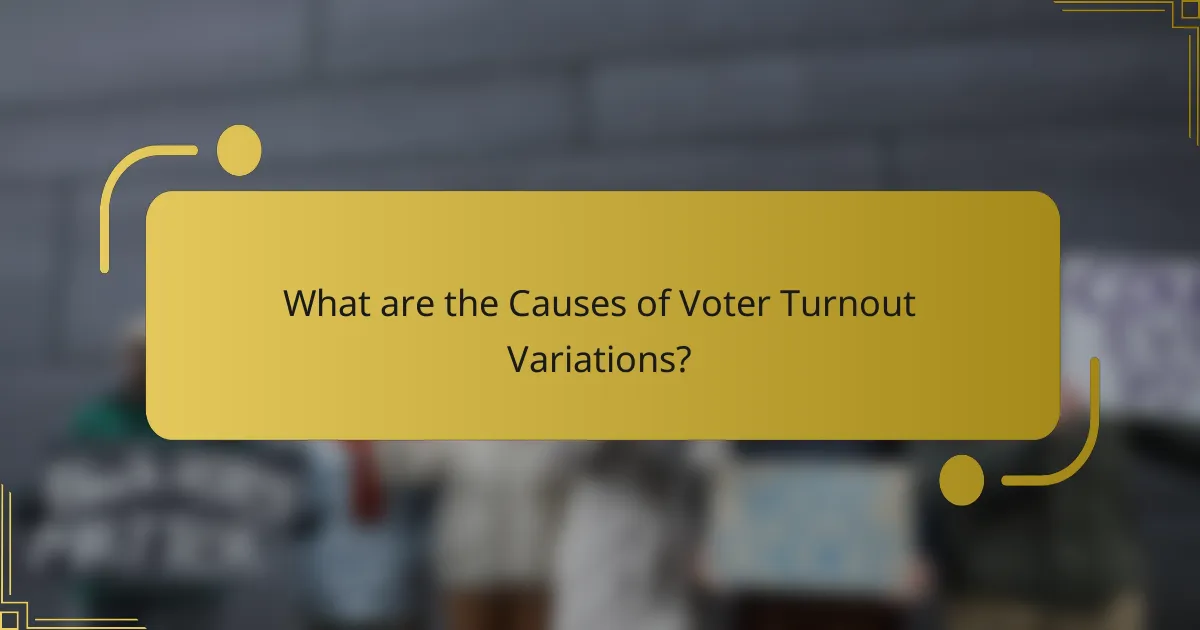
What are the Causes of Voter Turnout Variations?
Voter turnout variations are caused by multiple factors. Demographics play a significant role. Age, education, and income levels influence voting behavior. Younger voters typically have lower turnout rates. Higher education levels correlate with increased participation. Socioeconomic status also affects access to voting. Geographic location impacts turnout, with urban areas often showing higher rates. Election competitiveness can drive voter engagement. Significant issues on the ballot may motivate voters to participate. Historical data shows that presidential elections generally yield higher turnout than midterm elections. According to the U.S. Census Bureau, turnout in the 2020 presidential election reached 66.8%, the highest in over a century.
How do socioeconomic factors affect Voter Turnout?
Socioeconomic factors significantly affect voter turnout. Individuals with higher incomes and education levels tend to vote more frequently. In 2020, 79% of college graduates voted compared to 53% of those with only a high school diploma. Communities with lower socioeconomic status often face barriers such as lack of transportation and limited access to information. These barriers can decrease motivation and opportunity to participate in elections. Additionally, socioeconomic status influences political engagement and civic participation. Research shows that individuals in lower-income brackets often feel disenfranchised, impacting their likelihood of voting.
What role does education play in Voter Turnout?
Education significantly influences voter turnout. Higher levels of education correlate with increased participation in elections. Individuals with a college degree are more likely to vote compared to those with only a high school diploma. Studies show that educated voters are more informed about political issues and candidates. For example, the U.S. Census Bureau reports that in the 2020 election, 76% of college graduates voted, compared to 52% of those without a degree. This trend suggests that education equips individuals with the knowledge and skills necessary for civic engagement. Additionally, educational institutions often promote civic responsibility and involvement, further enhancing voter turnout among their students.
How does income level correlate with Voter Turnout?
Higher income levels correlate positively with higher voter turnout. Research shows that individuals with higher incomes are more likely to participate in elections. For instance, the U.S. Census Bureau reported that in the 2020 election, 79% of voters with household incomes above $100,000 cast their ballots. In contrast, only 53% of those earning less than $30,000 participated. This trend indicates that economic stability may enhance civic engagement. Additionally, higher income often provides access to resources that facilitate voting, such as transportation and time off work.
What influence do political factors have on Voter Turnout?
Political factors significantly influence voter turnout. Political engagement, party mobilization, and election competitiveness are key determinants. Higher levels of party organization lead to increased voter participation. For example, during the 2020 U.S. presidential election, strong ground game efforts by both major parties boosted turnout rates. Additionally, political climate and public sentiment can drive voters to the polls. In 2020, heightened concerns over issues like the pandemic and racial justice motivated many to vote. Research indicates that states with more competitive elections often see higher turnout. According to the U.S. Census Bureau, turnout in competitive states averaged 75% in 2020, compared to 55% in less competitive states. Thus, political factors play a crucial role in shaping voter turnout dynamics.
How do party affiliation and voter engagement impact turnout?
Party affiliation and voter engagement significantly impact voter turnout. Individuals who identify strongly with a political party are more likely to participate in elections. Research shows that in the 2020 U.S. presidential election, 81% of registered voters affiliated with the Democratic Party and 75% affiliated with the Republican Party cast their ballots. Higher levels of voter engagement, such as participation in campaigns and discussions about political issues, also correlate with increased turnout. Studies indicate that engaged voters are 50% more likely to vote compared to those with lower engagement levels. This suggests that both strong party affiliation and active engagement are crucial for mobilizing voters.
What effect do electoral competitiveness and campaigning have on Voter Turnout?
Electoral competitiveness and campaigning significantly increase voter turnout. Competitive elections create a sense of urgency and importance among voters. When candidates are closely matched, individuals feel their vote carries more weight. Campaigning amplifies this effect by actively engaging potential voters. Effective campaigns utilize strategies like door-to-door outreach and targeted advertising. These methods raise awareness and motivate participation. Research shows that higher competition correlates with increased turnout rates. For instance, the 2020 US presidential election saw a turnout of 66.8%, partly due to its competitive nature. Therefore, both competitiveness and campaigning are crucial for enhancing voter engagement.
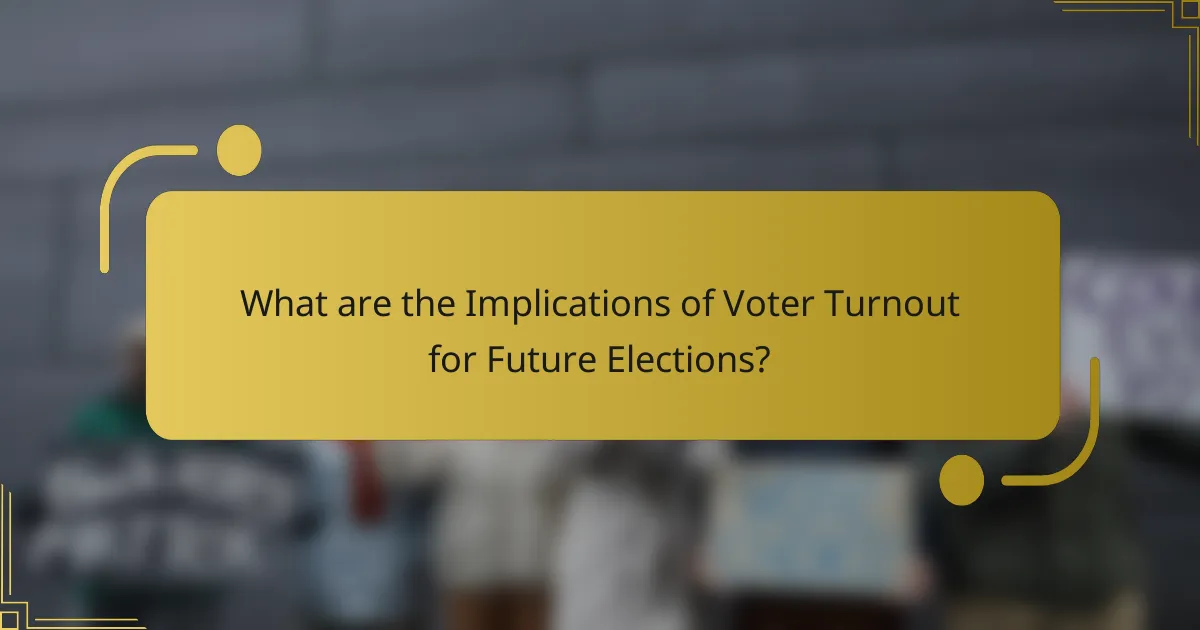
What are the Implications of Voter Turnout for Future Elections?
Higher voter turnout generally leads to more representative election outcomes. Increased participation can shift the political landscape significantly. For example, in the 2020 U.S. presidential election, turnout reached 66.7%, the highest since 1900. This surge resulted in a more diverse electorate influencing policy priorities. Future elections may see candidates adapting their platforms to appeal to a broader voter base. Additionally, sustained high turnout can encourage political engagement and activism. It may also prompt reforms aimed at improving accessibility and voting rights. Overall, the implications of voter turnout are profound for shaping democratic processes and outcomes.
How can understanding Voter Turnout trends inform future campaigns?
Understanding voter turnout trends can significantly inform future campaigns. Analyzing these trends helps identify which demographics are more likely to vote. Campaigns can tailor their messaging to resonate with these key groups. Historical data shows that younger voters have increased participation in recent elections. This trend suggests that campaigns should prioritize outreach to younger demographics. Additionally, understanding geographic turnout patterns can guide resource allocation. For example, areas with historically low turnout may require more engagement efforts. Campaigns that adapt strategies based on turnout data can enhance their effectiveness. This approach leads to more informed decisions and potentially higher voter engagement.
What strategies can political parties adopt to increase Voter Turnout?
Political parties can adopt several strategies to increase voter turnout. First, they can enhance voter registration efforts. This includes simplifying the registration process and offering same-day registration. Research shows that states with same-day registration see higher turnout rates.
Second, political parties can engage in targeted outreach. This involves identifying and mobilizing underrepresented groups. Data indicates that personalized outreach can significantly boost participation among these demographics.
Third, parties can invest in grassroots campaigning. Engaging local communities through town halls and door-to-door canvassing fosters connection. Studies reveal that face-to-face interactions increase voter engagement and turnout.
Fourth, utilizing digital platforms for voter education is essential. Social media campaigns can disseminate information about voting procedures and deadlines. Evidence suggests that online engagement can reach younger voters effectively.
Fifth, political parties should advocate for policies that make voting more accessible. This includes supporting measures like extended voting hours and mail-in ballots. Research shows that these policies correlate with increased voter turnout.
By implementing these strategies, political parties can effectively enhance voter turnout in elections.
How can technology enhance voter engagement and participation?
Technology can enhance voter engagement and participation through various means. Digital platforms enable easier access to voter information. Online registration simplifies the process for many individuals. Mobile applications can remind voters of upcoming elections and deadlines. Social media campaigns can raise awareness and encourage discussions about voting. Virtual town halls allow candidates to connect directly with constituents. Data analytics can identify and target underrepresented voter demographics. According to the Pew Research Center, 55% of voters reported using the internet to seek election information in 2020. These methods collectively contribute to increased voter turnout and informed participation.
What lessons can be learned from recent Voter Turnout rates?
Recent voter turnout rates indicate significant trends in civic engagement. Higher turnout often correlates with competitive elections. For instance, the 2020 presidential election saw a turnout of approximately 66.8%, the highest in over a century. This suggests that close races motivate voters to participate. Additionally, demographic shifts have influenced turnout. Younger voters, particularly those aged 18-29, increased their participation to 50% in 2020 compared to 36% in 2016. This highlights the importance of addressing issues relevant to younger demographics. Furthermore, accessibility measures, such as mail-in voting, have proven effective in boosting turnout. States that expanded voting access saw higher participation rates. Overall, these lessons underscore the need for continued efforts to engage diverse voter populations and ensure accessible voting processes.
How can civic education initiatives improve future Voter Turnout?
Civic education initiatives can significantly improve future voter turnout by enhancing citizens’ understanding of the electoral process. These initiatives teach individuals about their rights and responsibilities as voters. They also provide information on how to register and participate in elections. Research shows that informed citizens are more likely to vote. For instance, a study by the National Conference of State Legislatures found that states with robust civic education programs see higher voter participation rates. Additionally, civic education can foster a sense of civic duty. Engaged citizens are more likely to feel responsible for voting. This sense of responsibility can lead to increased turnout during elections.
What best practices can be implemented to ensure higher Voter Turnout in upcoming elections?
Implementing best practices to ensure higher voter turnout includes enhancing accessibility, promoting voter education, and increasing engagement. Accessibility can be improved by providing more polling locations and extended voting hours. Research shows that states with early voting options see a 10% increase in turnout. Voter education efforts should focus on informing citizens about registration processes and election dates. Studies indicate that well-informed voters are 20% more likely to participate. Increasing engagement through community outreach and mobilization campaigns can also drive turnout. Data from the 2020 elections revealed that targeted outreach led to a 15% rise in participation in specific demographics. These practices collectively foster an environment that encourages higher voter turnout.
The main entity of this article is voter turnout rates in recent US elections. The article provides a comprehensive analysis of voter turnout trends, highlighting significant statistics from the 2020 presidential election, where turnout reached 66.8%, and the 2018 midterms at 50%. It examines the measurement of turnout rates, the influence of demographics such as age, race, and income, and the implications of turnout on election outcomes and public policy. Additionally, the article explores the causes of variations in voter turnout and offers strategies for increasing engagement in future elections.
